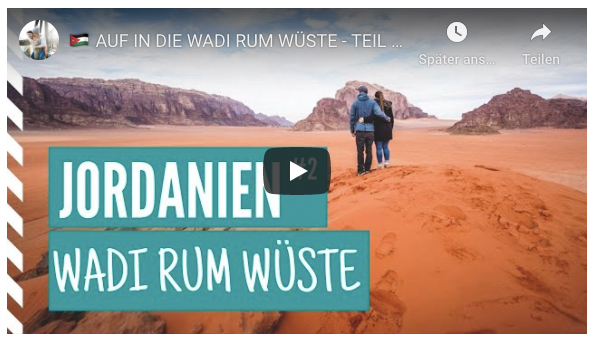We love deserts, vast expanses, silence, and a seemingly endless horizon. During our Jordan round trip, it was clear that we also wanted to travel to the Wadi Rum Desert. Shortly before our adventure in the rock-city of Petra, we arranged a tour with an overnight stay in a Bedouin camp. We were particularly excited about this adventure and could hardly wait to see this desert and its massive rock formations with our own eyes. In the following article, we would like to tell you everything about the Wadi Rum desert, about our experiences and the tour, as well as the costs and our highlights.
You should also know:
- Currency for Jordan
- Off to the Dead Sea
- Entry & Jordan Visa
- Best time to travel to Jordan
- Safety in Jordan
- Our Jordan Tips
- Our best Amman highlights
- Off to the Wadi Rum Desert
- Top Jordan Sights
- Everything about the rock city of Petra
- Round trip through Jordan
- You should also know:
- Wadi Rum Desert in Jordan
- How do I get to the Wadi Rum Desert?
- How much does admission cost?
- What tours are available?
- Where can I stay overnight in Wadi Rum?
- What are the local highlights?
- What do I need to pack for the Wadi Rum Desert?
- When is the best time to travel?
- Which tour did you do?
- Staying overnight at Candles Camp
- Conclusion on the Wadi Rum Desert & Video
Wadi Rum Desert in Jordan
“Wadi” means riverbed or valley, which only temporarily contains water after heavy rainfall. Wadis can be narrow, rocky valleys or kilometer-wide riverbeds. Wadi Rum (pronounced Wadi Ramm) is the largest wadi in the entire country, with a length of around 100 km and a width of up to 60 km. Furthermore, the wadi is located at an altitude of around 800 meters, with the highest mountains here reaching more than 1700 meters (Jabal Umm al-Dami and Jabal Ram).
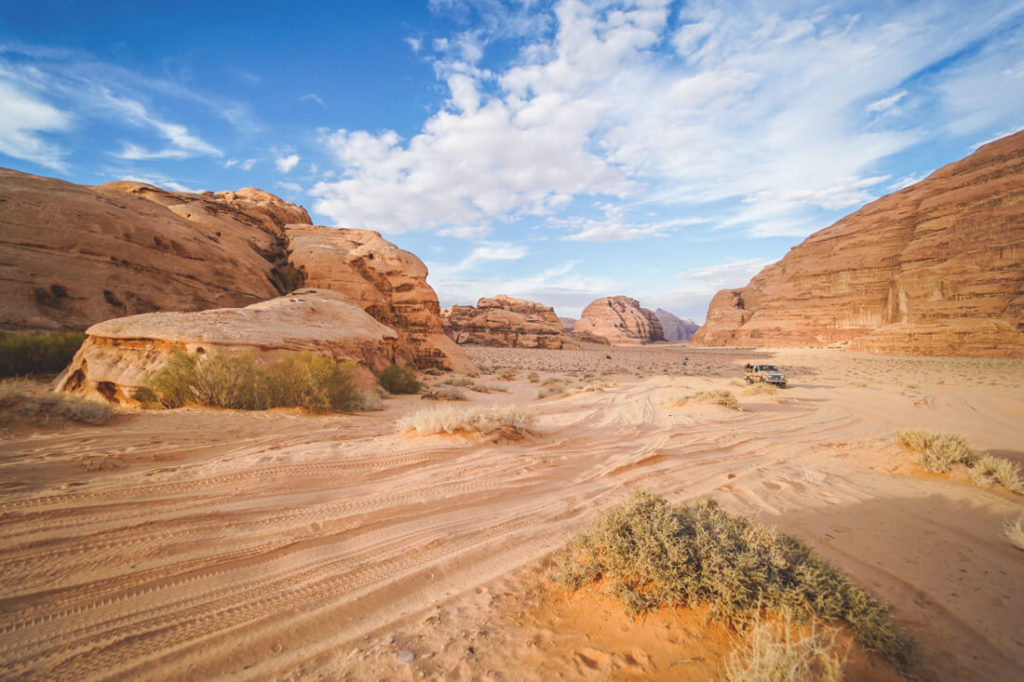
The unusual but also breathtaking desert landscape with rocky mountains towering steeply into the sky is truly impressive and should definitely not be missed on your trip through Jordan. In the village of Wadi Rum, many Bedouin families live in small houses and huts. They largely live off tourism and offer numerous tours. Whether it’s a jeep tour, overnight stays under the stars, climbing, mountaineering, hiking, paragliding, or hot-air balloon flights – Wadi Rum’s activities are pretty cool.
How do I get to the Wadi Rum Desert?
Wadi Rum Village is located in the south of the country, just under an hour’s drive from Aqaba. You can reach the Wadi Rum Visitor Center with your rental car via the Desert Highway and a detour onto the Wadi Rum Road. Here you’ll find parking, a police station, the access road to the village, as well as restrooms, shops, souvenir stores, a restaurant, and a small museum.
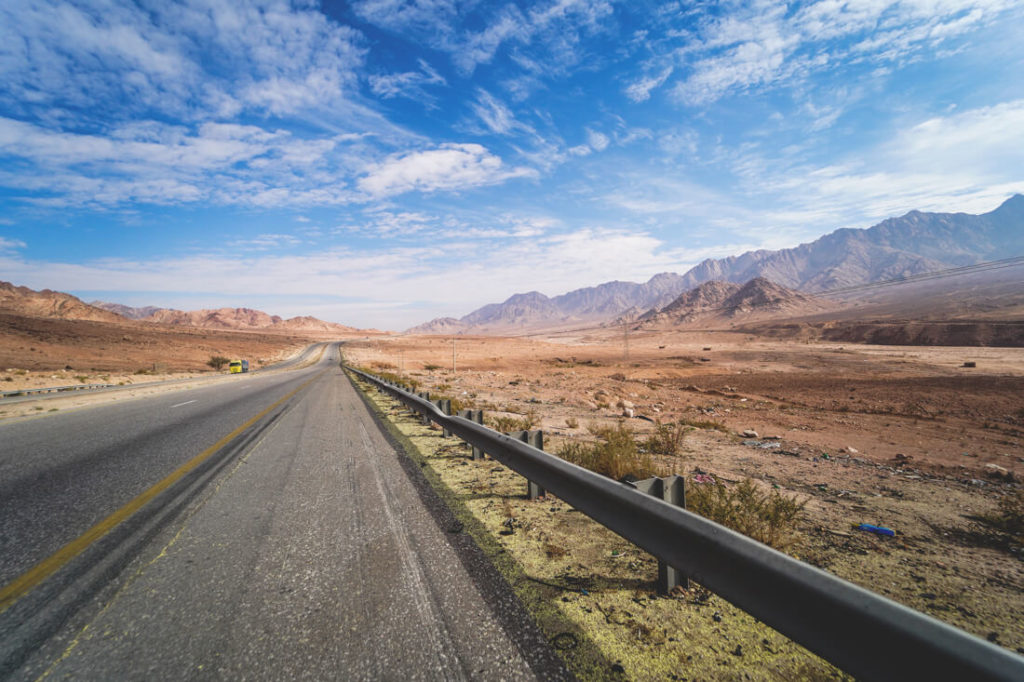
Many tours through the desert start from Wadi Rum Village. We also arranged to meet our tour guide here. A tourist bus departs from Wadi Musa every morning at 6 a.m. and goes to the Wadi Rum Rest House (just under 2 hours / approx. 7 JD). Alternatively, you can also take a taxi to Wadi Rum. From Petra, the trip costs 48 JD and from Aqaba 53 JD (as of January 2020).
How much does the entrance fee cost?
Before you reach the Wadi Rum Desert, you first have to go to the Visitor Center, just 6 kilometers from the village. Here you park your car, go to the reception, and either show your Jordan Pass or pay the 5 JD entrance fee. Children under 12 years old are free, and if you want to enter the desert with your own car (only with a 4×4), you pay 20 JD. You will also find a large overview map of the trails, highlights, and sights in the desert here. At the reception, you can get all the important information and, if necessary, book a tour.
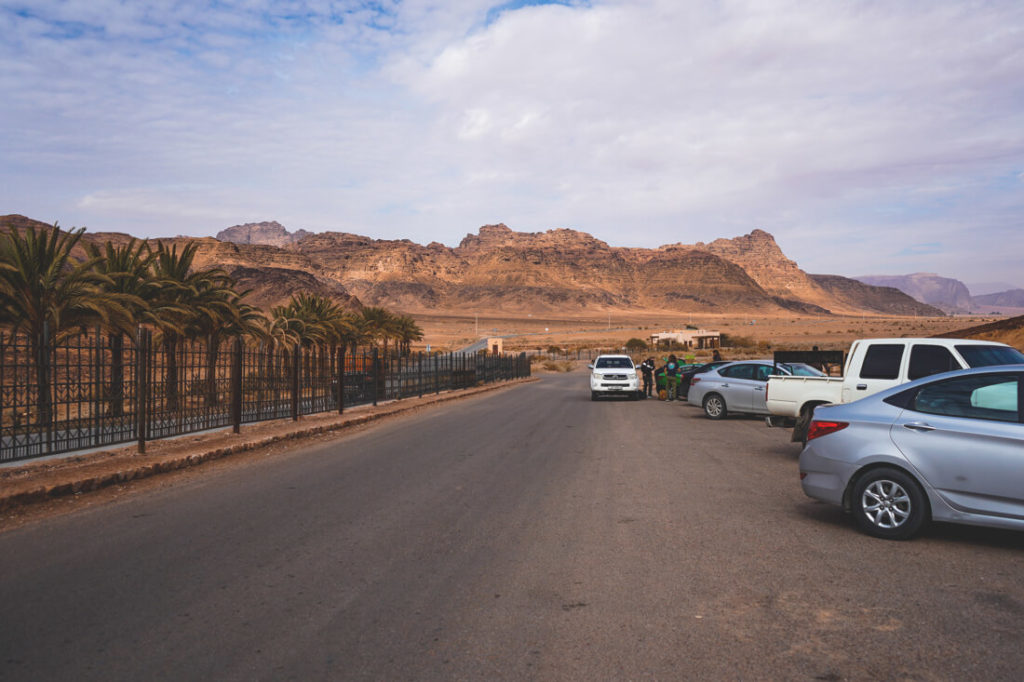
After you have presented your Jordan Pass at the reception or paid the 5 JD entrance fee, you can return to your car. Now you pass through the gate and drive about 6 km further to Wadi Rum Village. If you haven’t arranged a specific meeting point with your guide, you can park your car at the Wadi Rum Rest House and arrange your onward transportation from there.
What tours are available?
You can book various tours, depending on the provider. However, most offer trips lasting several hours, day tours, multi-day tours, camel tours, balloon flights, and trekking tours. You can either come to the desert for a few hours or book your trip with an overnight stay. Jeeps and guides are available at the visitor center to lead you through the desert for a few hours. Prices vary between 25 and 80 JD depending on the duration and distance.
You can also book your tour in advance with one of the many providers. We spent many hours researching online and comparing various providers. In fact, most offer the same packages at similar prices. In the end, a colleague at work gave us a recommendation, which we followed. You should definitely check the reviews of the individual providers and camps to avoid making a mistake.

We ultimately opted for a half-day tour with an overnight stay and booked our trip at the Wadi Rum Candles Camp*. Simply fill out the contact form with all the important information. You will then be contacted and your booking will be confirmed. After the tour and overnight stay, we had to pay100 JD (127€ for 2 people) in cash to our guide 1.
Where can I stay in Wadi Rum?
There aren’t many options, as there are no hotels in the Wadi Rum desert. However, according to our guide, you can choose between around 100 camps and a few campsites. Some are better equipped than others. There are even these luxurious bubble tents*, which offer a little more comfort in the middle of the desert. We definitely wanted to stay in one of the typical camps without all the luxury frills. At Booking.com*, you’ll find a large selection of camps where you can book your tent in advance for as little as €3 (note: a tour is not included in these prices).
If you book your night via Booking.com, the camp staff will pick you up from Wadi Rum Village (a fee may apply) and take you to the camp. From there, you can start one of the offered tours. You can also set off on foot from the camp and hike a bit through the desert. Our camp was beautifully situated on a steep rock face, where we could explore some cool spots.
What are the local highlights?
The Wadi Rum Desert is home to not only seemingly endless expanses and reddish-brown rock giants, but also wonderful spots such as rock canyons, springs, 1,700-meter-high mountains, petroglyphs, sand dunes, rock bridges, several ruins, and other massive rock formations for which the Wadi Rum Desert is also known. The films “Lawrence of Arabia”, “The Martian” and “Transformers” were filmed here, among others.
The top highlights of the Wadi Rum Desert:
- Pillars of Wisdom (mountain formation)
- Lawrence House (ruins)
- Nabataean Temple at the foot of Jebel Rum
- Lawrence Spring (named after Thomas Edward Lawrence)
- Al Ghuroub viewpoint
- Khazali Canyon/ravine
- Burrah Canyon
- Mushroom Rock
- Small and large rock bridges (rock arches)
- Ancient petroglyphs and paintings
- Sand dunes
- Jebel Hash (1700 meter high mountain)
What do I need to pack for the Wadi Rum Desert?
That probably depends entirely on the time of year. In general, it gets quite cold in the desert in the evenings and at night. Maybe not necessarily in midsummer (June to August), but in all other months. We were in the Wadi Rum Desert in January (in winter) and were so glad we had our winter jackets with us. We were really freezing while driving in the open jeep because the wind was so freezing cold.
You should definitely bring a thick jacket and a sweater. Also sturdy shoes, as the sand is supposed to get incredibly hot in summer, and hiking, climbing, and running are much easier with shoes on. You can safely leave flip-flops and sandals in your backpack. A flashlight* is also recommended in case there is no electricity in the camp. In this case, you should also bring enough batteries for your camera (and smartphone).
It’s best to also bring a daypack* with you, in which you can store your camera, drinks, snacks, etc. If the sun is really blazing, you should definitely apply sunscreen and, if necessary, pack a hat. Most operators charge cash on site, so withdraw enough cash beforehand (note: there is no ATM in the village or at the visitor center).
When is the best time to visit?
You can generally visit the Wadi Rum Desert all year round. We were there at what was probably the worst time of year and still had a wonderful stay and really good weather for January. It was quite chilly, but still sunny and somehow pleasant. So if you are traveling to Wadi Rum in winter (December – February), you should bring a thick winter jacket.
The best time to travel to the Wadi Rum desert is definitely spring (April & May) and autumn (September, October & November). According to climate charts, it’s not quite as hot then, it rarely rains, and the evenings and nights are somewhat more pleasant than in winter. Summers (June to August) can be incredibly hot, with temperatures reaching 40°C and above. If you can handle these temperatures, go for it!
Which tour did you take?
We did our tour with Candles Camp. We were emailed in advance to confirm a meeting point and a time in the village. Here we met Mahdi, who showed us the parking lot and introduced our guide. We packed everything we needed in our small daypack and left the rest in the trunk of our car. Then we hopped into the jeep and the tour began. We were the only ones in the jeep, certainly due to the travel time (off-season).
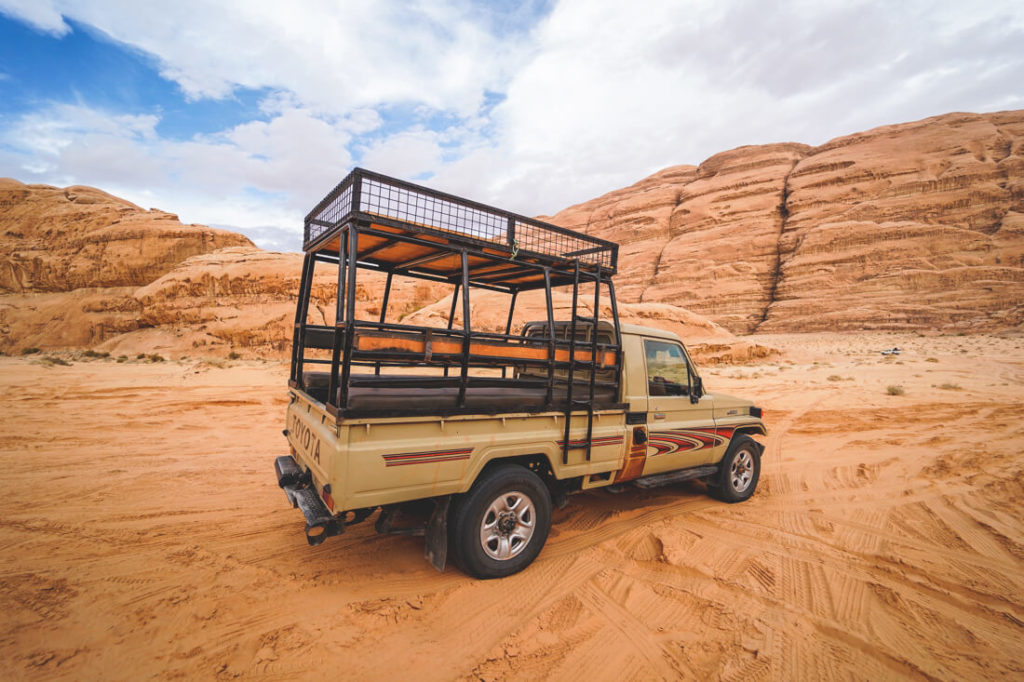
We were in the desert for almost 5 hours (including a beautiful sunset) before heading to camp. Our guide took us to a few spots but otherwise wasn’t particularly talkative. In general, we had the feeling that most guides just drive their guests from A to B without much interaction or conversation. However, it certainly varies greatly from guide to guide. At first, the weather was rather poor with dense clouds, which thankfully slowly disappeared after the first hour.
Our highlights and stops (5h)
- Lawrence Springs (Spring)
- Red sand dunes
- Khazali Gorge with fascinating inscriptions
- Small and large rock arches
- Sunset in the middle of nowhere
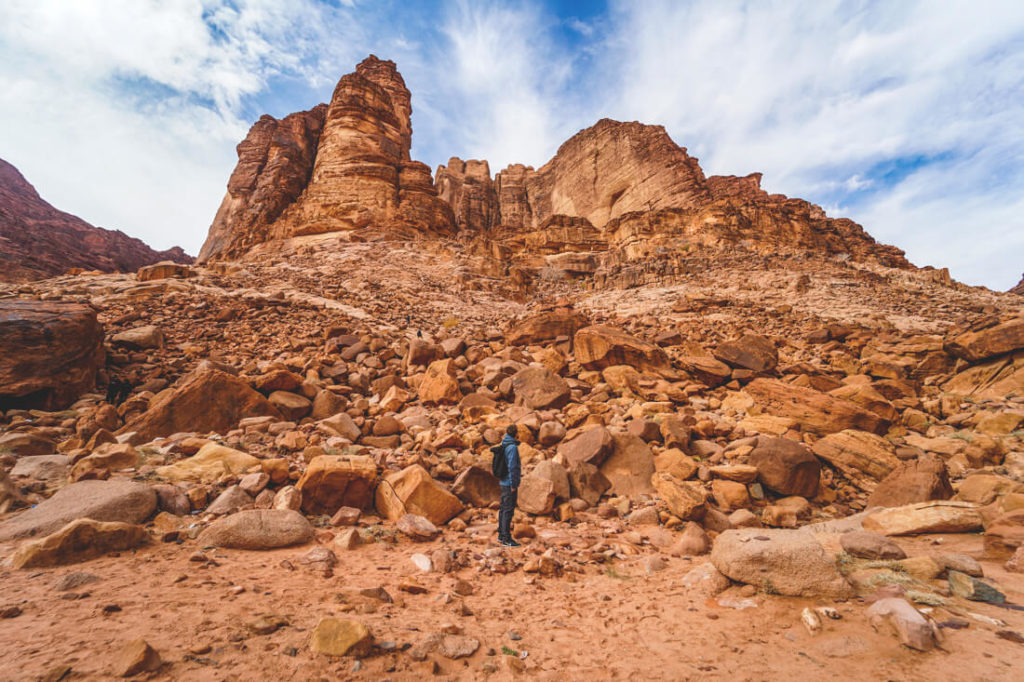




Overnight at Candles Camp
After the tour, we were taken to the camp. The Candles Camp (5 out of 5 points at Tripadvisor (from over 380 reviews) consists of simple tents for 2 people, 3 people, and families. There are also superior sanitary facilities with clean toilets and showers on site. The main tent is accessible via a few steps and offers plenty of space for eating and dancing together in the evening. A campfire was prepared in front of the tent, and we were served hot, fresh tea.
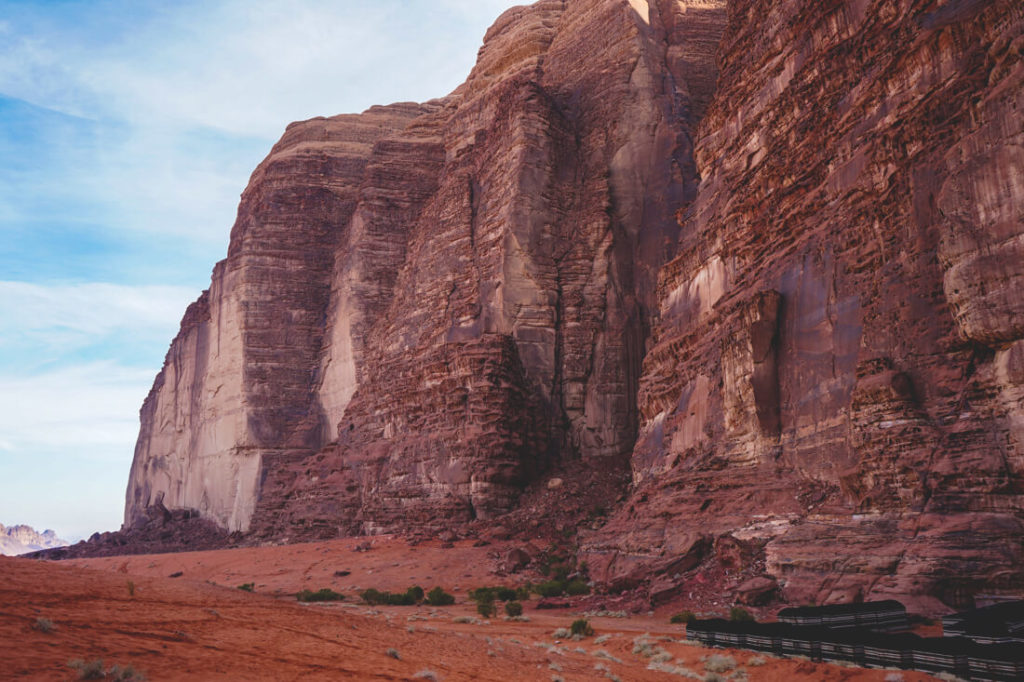
Dinner was delicious and consisted mainly of chicken, grilled vegetables, potatoes, salad, rice, sauces, hummus, soups, pastries, flatbread, and some other delicacies. Water and hot tea were always available. Afterwards, the guys played live music, and we were all able to enjoy the We ended the evening super relaxed, snuggled up in thick blankets. The guys were really super nice, in a good mood, and very friendly.
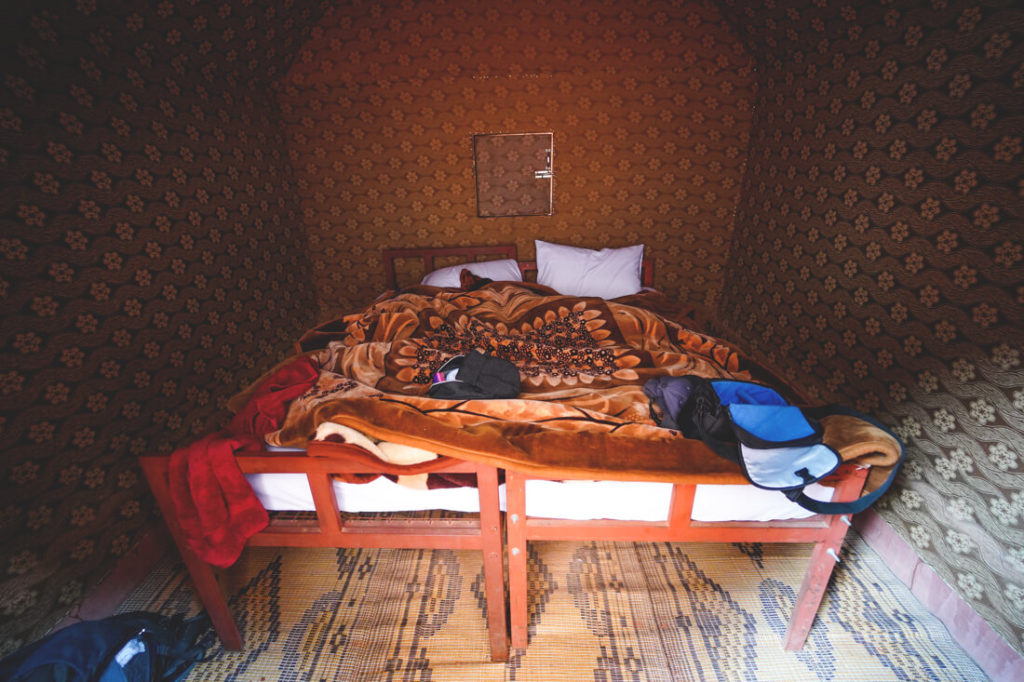
Then we went to our tent, which consisted only of a bed and thick blankets, but that was perfectly sufficient. Despite the icy temperatures, we didn’t freeze at all and were amazed at how warm the thick “horse blankets” (that’s what we always call them) kept us. The next morning, we were woken up for breakfast around 7 a.m. In the main tent, a kind of continental breakfast awaited us, including processed cheese, flatbread, hummus, sausage, jam, fruit, tea, and coffee. At around 8:15 a.m., we were driven back to the village to our car and paid our guide the 50 JD pp (63€) for our adventure.
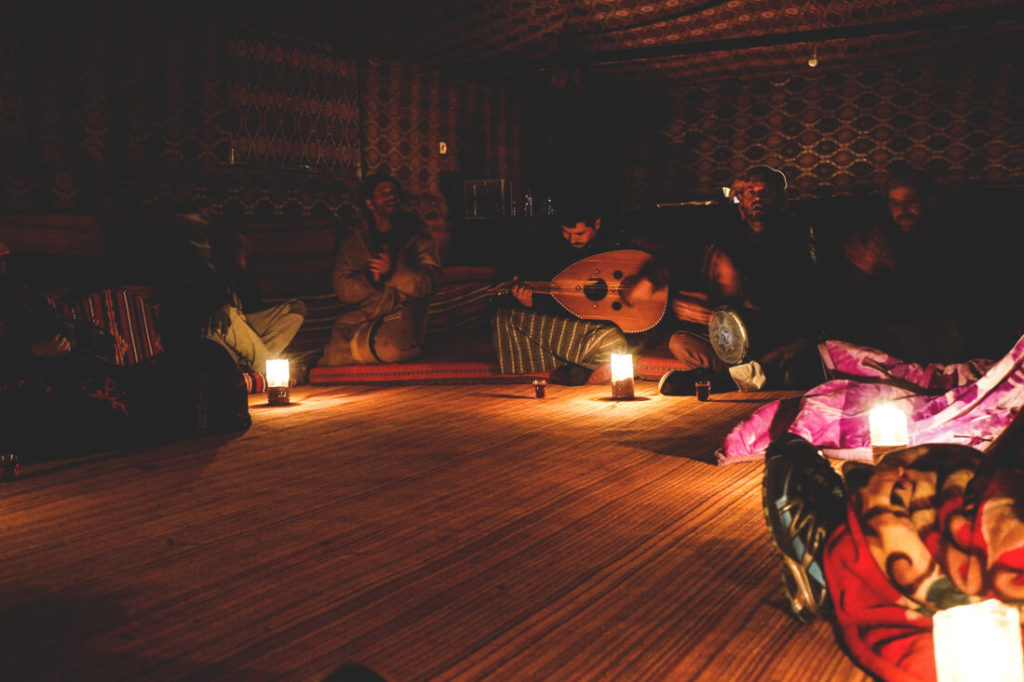
Conclusion on the Wadi Rum Desert & Video
We loved our stay in the Wadi Rum Desert and can only recommend such a tour to everyone. If it hadn’t been so cold, we would have happily stayed another day. Otherwise, the tour was perfectly adequate, and the overnight stay at the camp was also fantastic. Be sure to take a day and do at least a half-day tour with an overnight stay. This way, you can marvel at the desert’s starry sky and start the next morning refreshed after a breakfast amidst desert sand and rocky mountains.
